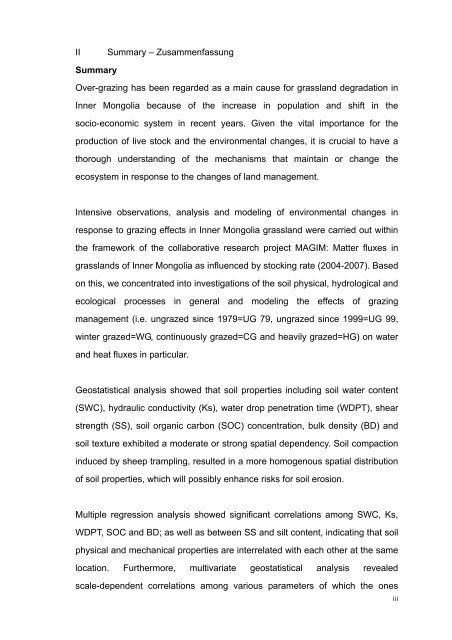SCHRIFTENREIHE Institut für Pflanzenernährung und Bodenkunde ...
SCHRIFTENREIHE Institut für Pflanzenernährung und Bodenkunde ...
SCHRIFTENREIHE Institut für Pflanzenernährung und Bodenkunde ...
Create successful ePaper yourself
Turn your PDF publications into a flip-book with our unique Google optimized e-Paper software.
II Summary – Zusammenfassung<br />
Summary<br />
Over-grazing has been regarded as a main cause for grassland degradation in<br />
Inner Mongolia because of the increase in population and shift in the<br />
socio-economic system in recent years. Given the vital importance for the<br />
production of live stock and the environmental changes, it is crucial to have a<br />
thorough <strong>und</strong>erstanding of the mechanisms that maintain or change the<br />
ecosystem in response to the changes of land management.<br />
Intensive observations, analysis and modeling of environmental changes in<br />
response to grazing effects in Inner Mongolia grassland were carried out within<br />
the framework of the collaborative research project MAGIM: Matter fluxes in<br />
grasslands of Inner Mongolia as influenced by stocking rate (2004-2007). Based<br />
on this, we concentrated into investigations of the soil physical, hydrological and<br />
ecological processes in general and modeling the effects of grazing<br />
management (i.e. ungrazed since 1979=UG 79, ungrazed since 1999=UG 99,<br />
winter grazed=WG, continuously grazed=CG and heavily grazed=HG) on water<br />
and heat fluxes in particular.<br />
Geostatistical analysis showed that soil properties including soil water content<br />
(SWC), hydraulic conductivity (Ks), water drop penetration time (WDPT), shear<br />
strength (SS), soil organic carbon (SOC) concentration, bulk density (BD) and<br />
soil texture exhibited a moderate or strong spatial dependency. Soil compaction<br />
induced by sheep trampling, resulted in a more homogenous spatial distribution<br />
of soil properties, which will possibly enhance risks for soil erosion.<br />
Multiple regression analysis showed significant correlations among SWC, Ks,<br />
WDPT, SOC and BD; as well as between SS and silt content, indicating that soil<br />
physical and mechanical properties are interrelated with each other at the same<br />
location. Furthermore, multivariate geostatistical analysis revealed<br />
scale-dependent correlations among various parameters of which the ones<br />
iii


